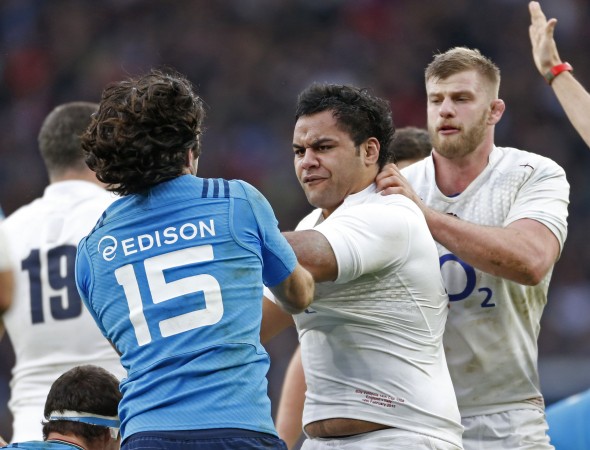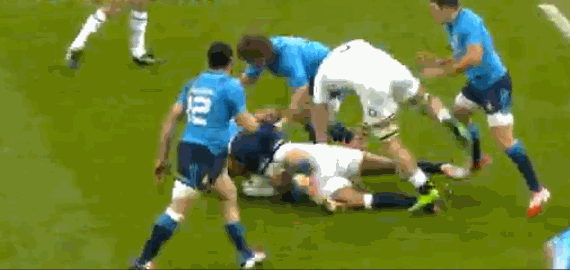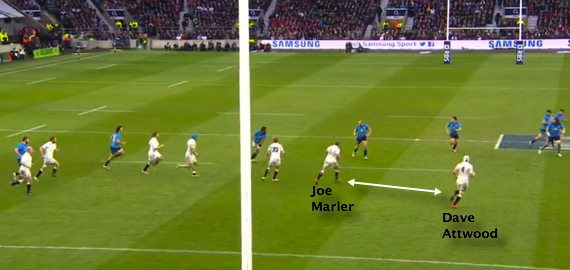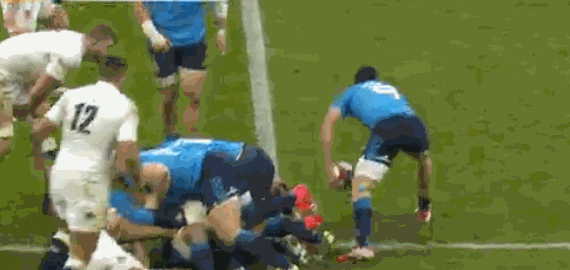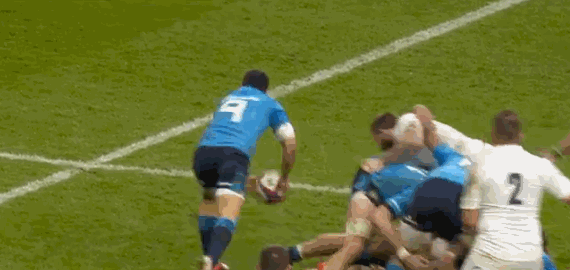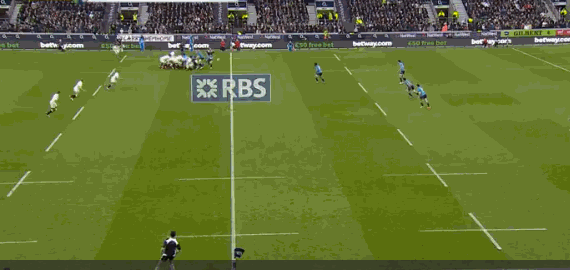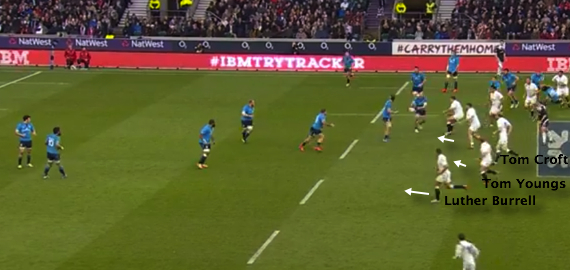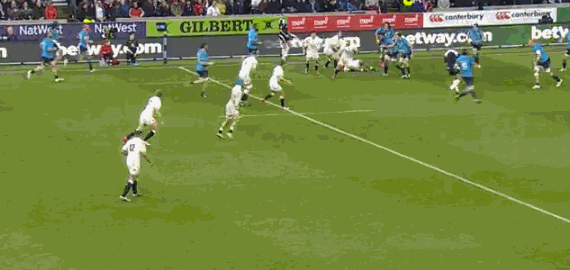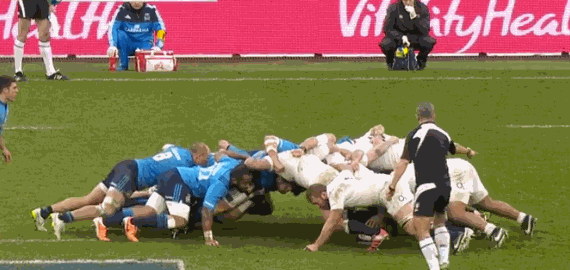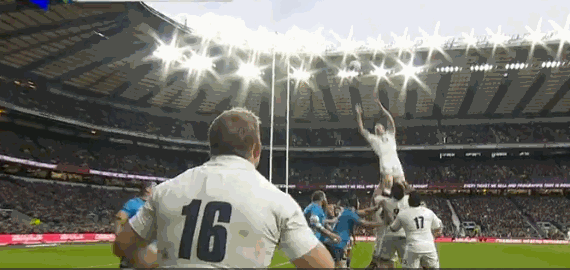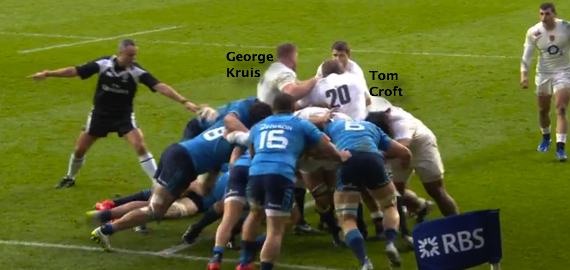England may have felt irritated at the final whistle on Saturday, but a 47-17 win over Italy brought plenty of reasons for optimism. We analyse the performance.
Rewind two years. England have just clung on to beat Italy 18-11, surviving a late bombardment of their try-line thanks in no small part to Chris Robshaw’s superhuman defensive effort. Afterwards, the talk is of relief, delight, a fourth consecutive Six Nations win and a Grand Slam shot in Cardiff.
Yesterday, the Azzurri suffered a 47-17 defeat. A few uncertain moments scattered England’s display, but the overall tone of the afternoon was authoritative. Even so, despite six tries and some fine attacking, each player felt palpable frustration at the final whistle.
Besides anything else, that is a pretty good gauge of progress. Here are five facets England can take away from the game.
Sluggish start and spacing
Statistics often fail to paint a fair picture. One number from the weekend will burn England defence coach Andy Farrell, though. His charges conceded eight line-breaks. That is one every the same figure an all-star Australian outfit managed back in November.
The bad habits began early, with Luca Morisi finding space from a stolen lineout within five minutes:
This is about an uncharacteristic lack of industry on second phase. After losing the set-piece, England are simply beaten around the corner.
The hosts stack up in midfield expecting their opponents to bounce back right, and are outnumbered. Anthony Watson is outflanked and only a combination of Mike Brown and Dave Attwood scramble to save the try:
Sergio Parisse did cross the line soon after this error, and another mistake was punished by Morisi for a try just after the break:
Organisation and spacing are the issue here. From the reverse angle, we can see how vulnerable the link between Attwood and Joe Marler is:
While Italy are on the front foot thanks to Leonard Sarto‘s chip-and-gather, this is still a significant lapse. Staying tighter would force protect Marler’s lack of pace Italy to put the ball through the hands – far from a foregone conclusion. As it happens, Morisi can simply feign a pass and slide through:
Ireland will obliterate such confusion on March 1. It must be ironed out.
Back-row blend
Now for the positives. Tom Wood is expected to have recovered from his ankle injury by the end of the month. Unfortunately for him, England’s loose forward trio of Robshaw, James Haskell and Billy Vunipola is functioning very well.
They made a combined total of 46 tackles against Italy, missing just three, and were involved in some pivotal plays too – some of which we will touch on later.
For now, watch this rescue act from Haskell, who hares down Samuela Vunisa to nab a crucial turnover:
This demonstrates both athleticism – Haskell bouncing to his feet rapidly – and intelligence, to swoop on the ball when he realises no ruck is formed.
Robshaw and Vunipola worked together for a similar effort later:
Rushing out to down Andrea Masi, Robshaw makes Italy pay for playing too much rugby in their own territory. Dan Cole latches on with Vunipola supporting – and therefore galvanising his prop’s position:
Turnovers into tries
Ben Smith‘s game-changing try in Dunedin last June was a lesson in smash-and-grab attack that shifted momentum from England to New Zealand in a flash. Snatching possession, the All Blacks went 70 metres in six passes and 15 seconds.
For a couple of scores on Saturday, England were as clinical. Here, Jonathan Joseph‘s first:
Obviously, the initial step is the turnover itself, which is once more a brilliantly-executed collective effort. Luther Burrell, who had an outstanding match under the radar, and Billy Twelvetrees hold up Morisi before the heavies – in the form of Robshaw and Vunipola – arrive.
Robshaw wrestles the ball to deck and places back for Ben Youngs:
Cole and Burrell shift it onto George Ford, who can look up to see a backline in disarray:
The rest is all about Joseph, and the reverse angle illustrates how he carries in two hands to create indecision in Giovanbattista Venditti:
Danny Cipriani‘s crowd-pleaser was the next try to come from a forced error:
As Italy gather Ben Youngs’ excellent box-kick, they have slow ball. That means England can launch at them with rapid line-speed:
Burrell, Tom Youngs and Tom Croft win the ruck as the ball is dropped and Cipriani, who had been covering the kick, can ht the line at pace from depth. His arc and intent holds the Italian fringe defence and frees up a two-on-two:
Twelvetrees ships onto Jonny May quickly, giving the Gloucester man a chance to back his speed, cutting back in and freeing an arm to find Cipriani’s clever, pre-emptive support line:
Twelvetrees brings backline together
Brown’s sickening head knock required a patch-up assignment from Stuart Lancaster, which was solved by shifting Anthony Watson to full back, Jonathan Joseph onto the right wing and introducing Twelvetrees at inside centre.
As he had been at the Millennium Stadium, the 26 year-old was very good, offering a kicking option and a second distribution outlet that really helped England’s fluidity. In the first half, this gorgeous floated pass to May should have brought a try:
Slotting in behind Ford, he bypasses Luke McLean to put his Kingsholm clubmate in acres of room:
Later on, Ford and Twelvetrees switched roles to conduct a wonderful strike move for Joseph’s second:
Runners in motion is the foundation here, and the move presented Lancaster with a fascinating conundrum – should this combination have more time together? It is worth tracking the whole thing, from where they set up at the scrum…
…to their running lines as Twelvetrees takes the ball flat and fires back to Ford…
…to how Ford manipulates the defence before fixing Masi and slipping Joseph in as Morisi drifts off to cover Watson:
Chopping and changing positions and personnel is difficult, especially during a Test match. Twelvetrees’ skills an communication eased the transition hugely.
Dealing with disruption
Italy‘s abrasive, full-blooded style has always required composure and persistence to break down. Over the 80 minutes, England built towards achieving that. It was a process, and examining two separate mauls can show us how Graham Rowntree‘s pack problem solved.
First, one on the stroke of half-time that was splintered and turned over:
Iconic Italian forwards Parisse and Martin Castrogiovanni plough through to seize the ball and hold it up:
Now watch how effectively England employ the same tactic to carry Nick Easter over the line:
Forming a barrier to halt any Azzurri spoilers, George Kruis and Croft are integral:
Then, the power of Tom Youngs and Billy Vunipola takes hold as England rumble towards the whitewash:
This surge brought England’s final points as Italy ended the game with a strong 12-minute spell. Perhaps that was a big reason for the general irritation among the squad. Now the emotion has subsided, they can look back and be generally happy.
That said, better is needed in Dublin. In two weeks, we will really learn the measure of this England side.





